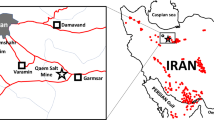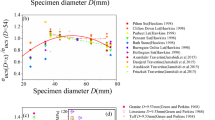Abstract
Salt rock is a crystalline material with a particular structure and different mechanical behavior. This inorganic material is a highly deformable rock, which shows creep under constant loads. This study attempts to estimate the properties and mechanical parameters of salt rock, such as uniaxial compressive strength, deformation modulus, Poisson’s ratio, internal friction angle, longitudinal wave propagation speed, and other related parameters by designing and performing the tests in accordance with valid standards in this context. Prismatic specimens were prepared from a salt rock dome, and the complete stress–strain curves in uniaxial compressive tests were determined. Comparison of salt rock strength and deformation characteristics with the brittle rock material shows significant difference between them. The results of tests have demonstrated the effect of the form of samples on their mechanical parameters. The ratio of the strengths under uniaxial loading of cylindrical samples to similar prismatic ones is about 0.83.







Similar content being viewed by others
REFERENCES
Chuanda, Zl., Observations of Acoustic Emission of Three Salt Rocks under Uniaxial Compression, Int. J. Rock Mech. and Min. Sci., 2015, vol. 77, pp. 19–26.
Yaser, E. and Erdogan, Y., Correlation Sound Velocity with the Density, Compressive Strength and Young’s Modulus of Carbonate Rocks, Rock Mech. and Min. Sci. J., 2004, vol. 41, pp. 871–875.
Hampel, A. and Schulze, O., The Composite Dilatancy Model: A Constitutive Model for the Mechanical Behavior of Salt Rock, The 6th Conf. on the Mechanical Behavior of Salt—SALTMECH6, Hannover, Germany, 22–25 May 2007.
Nazary, S., Mirzabozorg, H., and Noorzad, H., Modeling Time-Dependent Behavior of Gas Caverns in Salt Rock Considering Creep. Dilatancy and Failure, Tunneling and Underground Space Technol., 2013, vol. 33, pp. 171–185.
Zhang, Q., Liu, J., Wang, L., Luo, M., Liu, H., Xu, H., and Zou, H., Impurity Effects on the Mechanical Properties and Permeability Characteristics of Salt Rock, Energies, 2020, vol. 13, no. 6, P. 1366.
Vutukuri ,V.S. and Katsuyama, K., Introduction to Rock Mechanic, National Institute for Resources and Environment, Japan Industrial Publication and Consulting Inc., Tokyo, 1994.
Liang, W., Zhang, C., Gao, H., Yang, X., Xu, S., and Zhao, Y., Experiments on Mechanical Properties of Salt Rocks under Cyclic Loading, J. Rock Mech. and Geotech. Eng., 2012, vol. 4, no. 1, pp. 54–61.
Du, C., Yang, C., Yao, Y., Li, Z., and Chen, J., Mechanical Behavior Of Deep Salt Rock under the Operational Conditions of Gas Storage, Int. J. Earth. Sci. Eng., 2012, vol. 5, no. 6, pp. 1670–1676.
Abedi, F., Mousavi, M., Bahroudi, A., and Moazenian, A., Effect Of Solid Impurity on Creep Behavior of Salt Rocks of Hormoz Formation, Int. J. Min. and Geo-Eng., 2019, vol. 54, no. 2, pp. 161–166.
Li, H., Don,g Z., Ouyang, Z., Liu, B., Yuan, W., and Yin, H., Experimental Investigation on the Deformability, Ultrasonic Wave Propagation, and Acoustic Emission of Salt Rock Under Triaxial Compression, Appl. Sci., 2019, vol. 9, no. 4, P. 635.
Gorjiana, M., Moosavi, M., Memarianc, H., and Hendi, S., Temperature Effect on Static and Dynamic Properties of Salt Rock Case Study: Gachsaran Evaporitic Formation, Iran, ISRM Regional Symposium—7th Asian Rock Mechanics Symposium, 2012.
Jaeger, J.C., Cook, N.G., and Zimmerman, R., Fundamentals of Rock Mechanics, John Wiley and Sons, 2009.
ASTMC 170, Standard Test Method for Compressive Strength Dimension Stone, Annual Book of ASTM Standard, 2016.
Fahimi Far Ahmad, Rock Mechanics Tests; Theoretical Aspects and Standards, Soil Mechanics and Technical Laboratory, Ministry of Road and Transportation, Tehran, 1st Ed., 2014.
Mumivand, H. and Habibi, R., An Investigation into the Effect of Gas Storage Pressure Variations on the Stability of Salt Cavern, MSc Thesis, Faculty of Min. Eng., Urmia University, Iran, 2016.
ASTM D 2845-15, Standard Test Method for Laboratory Determination of Pulse Velocities and Ultrasonic Elastic Constants of Rock, Annual Book of ASTM Standard, 2015.
Author information
Authors and Affiliations
Corresponding author
Additional information
Translated from Fiziko-Tekhnicheskie Problemy Razrabotki Poleznykh Iskopaemykh, 2021, No. 3, pp. 51-59. https://doi.org/10.15372/FTPRPI20210306.
Rights and permissions
About this article
Cite this article
Moazenian, A.R., Abedi, F. Determining the Mechanical Characteristics of Prismatic Salt Rock Samples and Comparing Them with Cylindrical Ones. J Min Sci 57, 405–413 (2021). https://doi.org/10.1134/S1062739121030066
Received:
Published:
Issue Date:
DOI: https://doi.org/10.1134/S1062739121030066




